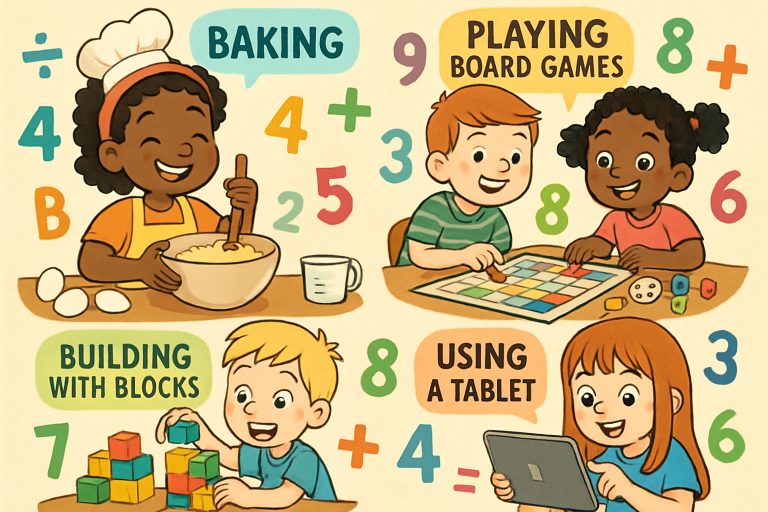Menu list
Introduction
Mathematics has a reputation for being a challenging and sometimes intimidating subject for kids. However, with a shift in approach and the integration of creativity and play, math can become an adventure filled with exploration and discovery. One of the best strategies is to embrace hands-on math fun early in a child’s learning journey to make the subject enjoyable and accessible.
Instead of separating math from the real world, connect it directly to kids’ interests and daily activities. This could mean turning a simple trip to the grocery store into a math experience or solving riddles together at the dinner table. Children can build a positive attitude toward math by harnessing curiosity and imagination while strengthening vital problem-solving skills.
There are countless ways to foster a love of math, and the most effective methods often combine fun, interaction, and real-world relevance. Exploring math through physical activities, games, and creative outlets such as art and music boosts understanding and keeps children engaged. This intentional approach helps explain why many educators and parents turn to resources that make learning playful and practical.
Parents and educators benefit from adopting strategies that transform math from a task into an opportunity for discovery. By integrating games and hands-on projects, children develop the confidence and motivation to tackle complex concepts as they grow.
Incorporate Math into Real-Life Applications
Learning math becomes meaningful when kids can see and feel its relevance. Real-life activities reinforce math concepts by demonstrating their everyday utility. For example, baking together is an excellent way to introduce measurements and fractions—halving a recipe or doubling ingredients naturally illustrate how numbers matter in the kitchen. Planning a family trip can bring up estimations, distance, time, and even budgeting, offering practical lessons in a relatable setting. When math is woven into routine experiences, it feels less like homework and more like a valuable tool for daily living.
Other activities, such as shopping or comparing prices, encourage children to calculate change or determine the best value, providing opportunities to practice mental math and critical reasoning. Research shows that connecting math to tangible outcomes builds confidence and reinforces the subject’s importance outside the classroom.
Utilize Educational Games and Puzzles
Games and puzzles bring math to life by turning practice into play. Board games like Monopoly and Chutes and Ladders introduce children to numbers, counting, money, and even strategic thinking. Card games like Uno or traditional math games can improve quick calculation skills, number sequencing, and logical reasoning. Engaging kids in regular family game nights offers quality bonding time while subtly strengthening their math foundation.
Online platforms and apps designed for children provide an ever-expanding library of math games that challenge kids at their skill levels. Puzzles—including Sudoku and crosswords—support the development of pattern recognition, quantitative reasoning, and attention to detail. By making learning a byproduct of fun activities, children approach math without anxiety or fear of failure.
Leverage Technology and Interactive Apps
Modern technology is an invaluable ally in making math engaging. Interactive apps offer personalized pathways that adapt to each learner’s needs and abilities, incorporating instant feedback and rewards. Many platforms use gamification to motivate children, introducing badges, levels, and challenges to keep them invested in their progress.
Websites such as Scholastic’s list of math apps showcase a range of free or low-cost tools designed to support children with basic arithmetic, algebra, geometry, and more. Parents can supplement classroom learning and provide extra practice in a format that resonates with today’s digital-native kids.
Engage in Hands-On Activities
Hands-on activities provide a concrete framework for abstract concepts. Activities like building with blocks, creating tangrams, or using measuring tapes help children physically manipulate math ideas, reinforcing spatial awareness and geometrical thinking. Cooking, planting a garden, or constructing simple DIY projects offer additional opportunities to introduce math so kids can touch, move, and explore.
When used intentionally, everyday objects such as coins, rulers, or even LEGO bricks become tools for counting, sorting, and problem-solving. These experiences help young learners visualize numbers and operations and highlight math’s practicality in familiar contexts.
Combine Math with Art and Music
Art and music effectively make math more engaging, especially for children with creative inclinations. Drawing geometric shapes, designing patterns, and creating mosaics are visually appealing methods to explore symmetry, repetition, and proportion. Origami interactively introduces angles and fractions, while building sculptures with clay or recycled materials can inspire lessons in measurement and estimation.
Music incorporates math through rhythm, patterns, and tempo. Clapping to the beat, organizing musical notes, or differentiating between time signatures are playful ways to practice counting and division. Fusing math with artistic and musical projects offers a multidisciplinary approach that supports learning across different domains.
Implement Reward Systems
Motivation is an essential factor in sustained learning. Establishing a reward system helps students set goals, track progress, and celebrate achievements. Rewards need not be extravagant—simple incentives like stickers, certificates, or extra playtime provide encouragement and a sense of accomplishment.
Visible progress charts or “math stars” boards recognize effort and highlight success. Children who associate math with positive experiences and recognition develop greater resilience and are more likely to embrace challenges instead of avoiding them.
Parents and educators can nurture enthusiasm and confidence in young learners by approaching math with creativity, real-world relevance, and plenty of encouragement. Math doesn’t have to be daunting—instead, it can be an endless source of curiosity, connection, and fun.





